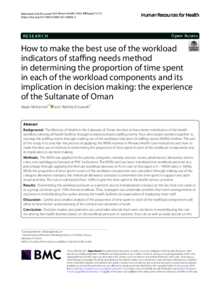وثيقة
How to make the best use of the workload indicators of staffing needs method in determining the proportion of time spent in each of the workload components and its implication in decision making : the experience of the Sultanate of Oman.
المعرف
DOI: 10.1186/s12960-021-00656-2
المصدر
Human Resources for Health. v. 19, 113
المساهمون
Al‑Lawatiyah, Nahida., مؤلف
الدولة
United Kingdom.
مكان النشر
London
الناشر
BioMed Central Ltd.
ميلادي
2022-01-01
اللغة
الأنجليزية
الموضوع
الملخص الإنجليزي
Background: The Ministry of Health in the Sultanate of Oman decided to have better distribution of the health workforce among all health facilities through evidenced-based staffing norms. Four directorates worked together to develop the staffing norms through making use of the workload indicators of staffing needs (WISN) method. The aim of this study is to describe the process of applying the WISN method in Primary Health Care institutions and how to make the best use of method in determining the proportion of time spent in each of the workload components and its implication in decision making. Methods: The WISN was applied for five priority categories, namely, doctors, nurses, pharmacists, laboratory technicians, and radiology technicians at PHC institutions. The WISN ratio has been translated into workload pressure as a percentage through applying the formula [workload pressure as % (in case of shortage) = (1 − WISN ratio) × 100%]. While the proportion of time spent in each of the workload components was calculated through making use of the category allowance standard, the individual allowance standard to determine the time spent in support and additional activities. The sum is subtracted from 100% to give the time spent in the health service activities. Results: Determining the workload pressure as a percent and its interpretation is based on the fact that one cadre or as a group can bear up to 10% of extra workload. Thus, managers can undertake sensible short-term arrangements or decisions in redistributing the cadres among the health facilities on expectation of deploying more staff. Discussion: Careful and detailed analysis of the proportion of time spent in each of the workload components will allow to have better understanding of the context and dynamics of work. Conclusion: Decision makers and planners can undertake rational short-term decisions in redistributing the cadres among the health facilities based on the workload pressure. In addition, they can as well as easily decide on the optimal proportions of time for each staff category, and hence choose what activities and tasks to be shifted or delegated to other staff category.
ISSN
1478-4491
قالب العنصر
مقالات الدوريات

